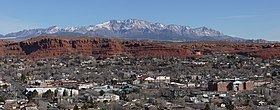Elevation 10,365 ft (3,159 m) Width 28 mi (45 km) E/W | Length 35 mi (56 km) N/S Country United States Area 1,531 km² | |
 | ||
Pine valley mountains utah hiking signal peak hidden forest and whipple valley
The Pine Valley Mountains are a mountain range in the U.S. state of Utah spanning Washington County north of the city of St. George. The highest point in the range is Signal Peak at 10,365 feet (3,159 m). The mountains are part of Dixie National Forest and are bordered to the south by the Red Cliffs National Conservation Area.
Contents
- Pine valley mountains utah hiking signal peak hidden forest and whipple valley
- GeologyEdit
- WildernessEdit
- Flora and faunaEdit
- RecreationEdit
- References
GeologyEdit
The Pine Valley Mountains formed from the Pine Valley Laccolith, which is the largest laccolith in the United States and perhaps the largest laccolith in the world. The laccolith was formed during a 20 million-year period of volcanic activity. After 4-5,000 feet of volcanics had been deposited on top of the Claron Formation, the magma vents were effectively sealed off. A final surge of magma, unable to find its way to the surface, instead pushed sideways along the weak seam between the Claron and the overlying volcanic layers. Thus was injected a 3,000 foot-thick layer of monzonite porphyry to form the Pine Valley laccolith. The contact between the top of the Claron and the bottom of the laccolith can be seen in several locations, most notably near the headwaters of Cottonwood Creek along the southwest corner of the mountain range (see photo below in the gallery), and at the headwaters of Leap Creek north of the Browse Guard Station.
After erosion exposed the laccolith, volcanic activity continued and the youngest flows are 1-1.6 million years old. Many volcanic cinder cones can still be seen in the foothills of the Pine Valley Mountains and these have been dated at around 20,000 years old. As a result of these lava flows, the valley for which the mountain range is named and in which the town of Pine Valley is situated, was formed when lava dammed off the Santa Clara River and formed a lake. Sediments eventually filled the lake until they reached the height of the lava dam. These sediments form the floor of the present day Pine Valley, Grass Valley, and Grassy Flat.
The mountains straddle the divide between the Great Basin watershed and the watershed of the Virgin River, a tributary of the Colorado River. The Chinamen's Canal tunnel at the north end of Grass Valley diverts the waters of Mill Canyon Creek from the Colorado River drainage system into the Great Basin drainage system, eventually finding its way into the Newcastle Reservoir via Pinto Creek.Zion National Park can be seen to the east from the mountains.
WildernessEdit
Part of the range is in the Pine Valley Mountain Wilderness, which at 50,232 acres (20,328 ha) is the fourth largest wilderness in Utah. The 2,643 acres (1,070 ha) Cottonwood Forest Wilderness is located at the southeastern end of the range.
Flora and faunaEdit
The Pine Valley Mountains support spruce-fir forests, including a large stand of virgin Engelmann spruce. The mountains also have numerous meadows up to 50 acres (20 ha) in size. Several threatened, endangered, and sensitive species live in the mountains, including Bonneville cutthroat trout, Townsend's big-eared bat, and the pygmy rabbit, among others.
Botanically speaking, Pine Valley Mountain is the most diverse mountain range in Utah. A floristic survey was conducted between 1985 and 1987 and 967 species were collected. Since then, additional species have been added bringing the total to nearly 1,000. Three species new to Utah were identified including bitter cherry (Prunus emarginata (Dougl.) Walpers), common sandweed (Athysanus pusillus (Hook.) Greene), and Lemmon’s onion (Allium lemmonii S. Wats.). Nineteen ferns and fern allies are present, 18 gymnosperms (conifers and Mormon teas), 150 species of monocots (including 86 grasses, 10 orchids, and 2 agaves, among others), with the remainder being dicots. The three largest families represented in the flora of Pine Valley Mountain include the Asteraceae with 160 species, Poaceae with 85 species, and Fabaceae with 63. The three largest genera and number of species collected are Eriogonum, 23, Cryptantha, 20, and Astragalus, 20. Some of the more interesting finds include:
All but one of Utah’s conifers grow in the Pine Valley Mountains. Only the lodgepole pine (Pinus contorta Douglas) is missing.
RecreationEdit
There are numerous opportunities for recreation in the mountains, including hiking, rock climbing, camping, wildlife watching, fishing, hunting, horseback riding, and boating on a reservoir.
